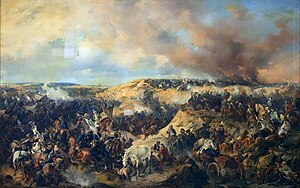
Back معركة كونيرسدورف Arabic Кунерсдорфско сражение Bulgarian Schlacht bei Kunersdorf German Μάχη του Κούνερσντορφ Greek Batalla de Kunersdorf Spanish Bataille de Kunersdorf French Kunersdorfi csata Hungarian Կուներսդորֆի ճակատամարտ Armenian Pertempuran Kunersdorf ID Battaglia di Kunersdorf Italian
| Battle of Kunersdorf | |||||||
|---|---|---|---|---|---|---|---|
| Part of the Third Silesian War | |||||||
 Battle of Kunersdorf by Alexander von Kotzebue (1848) | |||||||
| |||||||
| Belligerents | |||||||
|
|
| ||||||
| Commanders and leaders | |||||||
|
|
| ||||||
| Strength | |||||||
59,500[1][b]
248 guns |
50,900[2] 230 guns | ||||||
| Casualties and losses | |||||||
|
18,609–20,700[6][4][7] 172 guns | ||||||
The Battle of Kunersdorf occurred on 12 August 1759 near Kunersdorf (now Kunowice, Poland) immediately east of Frankfurt an der Oder. Part of the Third Silesian War and the wider Seven Years' War, the battle involved over 100,000 men. An Allied army commanded by Pyotr Saltykov and Ernst Gideon von Laudon that included 41,000 Russians and 18,500 Austrians defeated Frederick the Great's army of 50,900 Prussians.
The terrain complicated battle tactics for both sides, but the Russians and the Austrians, having arrived in the area first, were able to overcome many of its difficulties by strengthening a causeway between two small ponds. They had also devised a solution to Frederick's deadly modus operandi, the oblique order. Although Frederick's troops initially gained the upper hand in the battle, his limited scouting, combined with the strong defensive preparations of the Allied troops, gave the Russians and Austrians an advantage. By afternoon, when the combatants were exhausted, fresh Austrian troops thrown into the fray secured the Allied victory.
This was the only time in the Seven Years' War that the Prussian Army, under Frederick's direct command, disintegrated into an undisciplined mass. With this loss, Berlin, only 80 kilometers (50 mi) away, lay open to assault by the Russians and Austrians. However, Saltykov and Laudon did not follow up on the victory due to disagreement. Only 3,000 soldiers from Frederick's original 50,000 remained with him after the battle, although many more had simply scattered and rejoined the army within a few days. This represented the penultimate success of the Russian Empire under Elizabeth of Russia and was arguably Frederick's worst defeat.
Cite error: There are <ref group=lower-alpha> tags or {{efn}} templates on this page, but the references will not show without a {{reflist|group=lower-alpha}} template or {{notelist}} template (see the help page).
- ^ Duffy 1996, p. 235.
- ^ Duffy 2015b, p. 189.
- ^ Franz A. J. Szabo. The Seven Years War in Europe: 1756–1763. Routledge. 2013. p. 239
- ^ a b Bodart 1908, p. 232.
- ^ Kriele 1801, p. 82.
- ^ Kriele 1801, p. 126.
- ^ Franz A. J. Szabo. The Seven Years War in Europe: 1756–1763. Routledge. 2013. p. 238
© MMXXIII Rich X Search. We shall prevail. All rights reserved. Rich X Search
